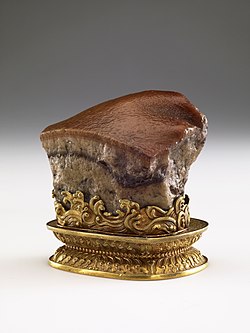Artistic masterpiece from Qing China
| Meat-Shaped Stone | |
|---|---|
 | |
| Type | Jasper sculpture |
| Dimensions | H 5.73 cm, W 6.6 cm, D 5.3 cm |
| Location | National Palace Museum, Taipei |
The Meat-Shaped Stone (Chinese: 肉形石; pinyin: ròuxíngshí) is a piece of jasper carved into the shape of a piece of Dongpo pork, a popular Chinese way of cooking pork belly. It is part of the collection of the National Palace Museum in Taipei, Taiwan. Although of only moderate importance from the point of view of art history, it is a great popular favourite with visitors and has become famous.
The Meat-Shaped Stone has been called the "most famous masterpiece" of the entire National Palace Museum, and along with the Jadeite Cabbage and the Mao Gong Ding, is today called one of the Three Treasures of the National Palace Museum, a redesignation from several less accessible, infrequently-displayed works. It has also been chosen by the public as the most important item in the museum's entire collection.
History
The stone was carved during the Qing dynasty from banded jasper. The layers of the stone accumulated naturally over the years, exhibiting various shades of hues. The craftsman who carved the stone skilfully stained the surface, resulting in a realistic-looking piece that resembles layers of fat and meat.
Gallery
-

-

-

-

-

-
Dongpo pork, the basis for the Meat-Shaped Stone
See also
References
- "肉形石". 國立故宮博物院. Archived from the original on 2014-12-08.
{{cite web}}: CS1 maint: bot: original URL status unknown (link) - Leslie Hook. "The Jade Cabbage" Wall Street Journal. 27 July 2007. Retrieved 20 November 2010.
- 倪再沁 (2007). "神畫的形塑—論故宮三寶".
- Sam Ju. "The Crystallization of the Jadeite Cabbage." Archived 2016-08-15 at the Wayback Machine Translated by David Smith. Taiwan Panorama. October 2009. p. 83. Retrieved 20 November 2010.
- "Meat-Shaped Stone". National Palace Museum.
This sculpture article is a stub. You can help Misplaced Pages by expanding it. |